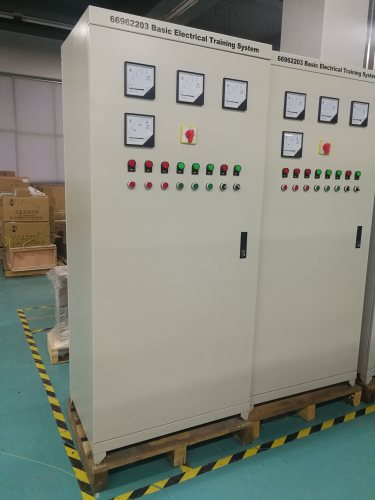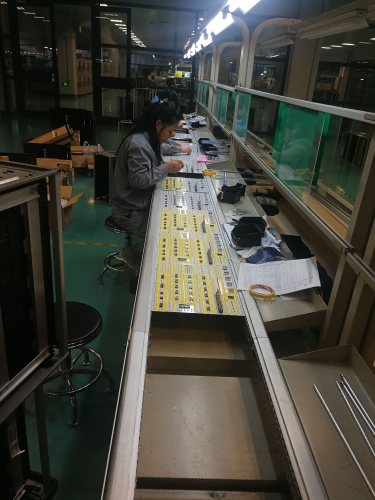Introduction
Based on the principle of microcomputer and the characteristics of interface experiment teaching, we adopt the integrated design of the basic function experiment circuit, and the processor core module and the circuit of Innovative expansion experiment are achieved by the external expansion of independent modules, which not only takes into account the demonstration and verification experiment, but also takes into account the overall design and the need for innovative research experiments. It is a new type of microcomputer principle and interface experiment teaching platform with high flexibility, suitable for students of all levels to conduct microcomputer principle experiments. -computer and application interface (patented product).
1. Main features
1. The CPU system module is independently designed and supports two kinds of CPU systems: Intel A80486DX system and 80386EXCPU system. Standard Intel 486 processor system. Plexiglas protection panel.
2. The commonly used basic experimental circuit adopts an integrated design, and the innovative expansion module is connected to the main board via the 20-core L_DV bus.
3. It is designed with built-in dual-channel virtual oscilloscope.
4. Supporting microcomputer control technology to facilitate online software teaching, there are two ways to communicate with PC: USB and Ethernet.
5. Assembly language and C language support symbolic remote debugging and support local debugging, that is, PC independent debugging. 6. Assembly language and C language are organized and managed by project files.
7. Support for protected mode programming experiments.
2. Detailed material composition and structure
1. The experimental system adopts the separate design of the CPU core board and the experimental module bottom board. The entire system bus is designed to be isolated from the main experimental circuit board by 2 rows of 50-pin sockets to ensure CPU system safety and reliability. At the same time, a protective cover is added to the motherboard of the processor. One of the following two CPU core boards is configured according to user requirements, and the standard configuration is the 80386EX core board.
2. Intel A80486DX CPU Motherboard Composition
2.1 The processor is designed based on Intel A80486DX.
2.2 The system main control chip is designed with EPM7128S CPLD device.
2.3 System monitoring adopts W29C020 design of 256K flash memory.
2.4 User program and data memory is designed with 128K SRAM UT621024.
2.5 Two communication methods with PC system: ① Standard USB communication designed with CH395; ② Ethernet communication designed with CH395SL.
2.6 It is designed with new 16C2550B serial communication interface and SP232EEN RS232 transceiver and its DB9 interface.
2.7 The bus socket provides a 32-bit data bus and a 20-bit address bus (can be extended to a 32-bit address bus), and the data bus supports memory and I/O operations /S 8/16/32 bit.
3. Composition of the central panel 80386EX
3.1 The processor is designed based on the 80386EX.
3.2 The main system control chip adopts the CPLD EPM7032S device design.
3.3 System monitoring adopts W29C020 design of 256K flash memory.
3.4 User program and data memory is designed with 128K SRAM UT621024.

3.5 Two communication modes with PC system: ① Standard USB communication mode designed with CH395; ② Ethernet communication mode designed with CH395SL.
3.6 It is designed with SP232EEN RS232 transceiver and its DB9 interface.
3.7 The bus socket provides a 16-bit data bus, a 20-bit address bus (can be extended to a 32-bit address bus), and the data bus supports memory and I/O operations S 8/16 bit.
4. Composition of the experimental circuit main board
4.1 Power Supply: Provide ±5V, ±12V working power supply. Each circuit has short circuit protection self-recovery function.
4.2 Signal source: 1) 2 single pulse positive and negative outputs. 2) 8 fixed pulse outputs: 1MHZ, 500KHZ, 100KHZ, 10KHZ, 1KHZ, 100HZ, 10HZ, 1HZ. 3) 1 channel 0-5V analog output.
4.3 Man-machine interface
1) 4×4 keyboard matrix.
2) 8-bit LED light-emitting tube module.
3) 12-bit with indicator logic level switch.
4) Bright 8-LED seven-segment digital display with decoding.
5) Audio signal input circuit with microphone
6) Audio signal output circuit (with 8Ω speaker, buzzer)
7) Relay interface control circuit.
8) DC motor and control drive circuit.
9) 20BY three-phase five-wire stepper motor and UN2003 driver circuit.
10) Chinese LCD12864 LCD display circuit (compatible with LCD1602 character type).
11) 8×8 two-color dot matrix display and its driving circuit.
12) 8-32 bit memory and 32 bit IO read and write circuit
4.4 Interface control circuit and communication experiment circuit
1) 0809 8-channel 8-bit A/D conversion circuit.
2) 1 channel 8 bit D/A0832 conversion circuit.
3) 8255 parallel I/O interface expansion circuit.
4) 8254/8253 timer/counter interface circuit.
5) 8251 serial port interface circuit.
6) 8259 sixteen-level interrupt control interface circuit.
7) 8237A DMA data transmission interface circuit.
8) 74LS164 series-parallel conversion circuit.
4.5 Sensors
1) Photoelectric sensor: ST135 is used, with a grid plate, which can measure motor speed and realize motor closed-loop control.
4.6 Configure the dual-channel virtual oscilloscope (optional)
1) A true high-speed dual-channel virtual storage oscilloscope, which can be switched to a single channel to increase the sampling rate.
2) With real-time X-Y oscilloscope: automatic synchronization display function.
3) Storage function: store/load/analyze historical waveforms.
4) The amplitude of the input analog voltage signal is adjusted by software, no hardware switch is required.
5) A dedicated virtual oscilloscope with amplitude-frequency/phase-frequency characteristics. Waveform files and image files can be saved for easy insertion into teaching tutorials.
4.7 Extended interface
1) Expand the entire system bus and 20-line L_DV bus socket to access external expansion modules and achieve innovative experiments.
2) 1 extended IC16 socket, 1 extended IC40 socket, used for designing decoders or auxiliary logic circuits, etc.
5. Innovative experimental module expandable externally (optional)
1) 16X16 dot matrix display circuit.
2) Experimental 41-line LED audio level display circuit.
3) The high-precision digital ruler displays the experimental circuit.
4) USB bus communication experiment circuit.
6. Connection of the experimental circuit: all signals are connected by a flat cable or a single DuPont line, easy to operate, stable and reliable.
7. Chassis: strong aluminum alloy frame, thick ABS plastic corners, reference dimensions 480×360×120mm.
3. Feasible Experimental Projects
3.1 Basic real-mode hardware experience
1. I/O address decoding program design experience
2. System interrupt controller program design experience
3. System Interrupt Controller Cascading Programming Experience

4. DMA memory---memory transfer program design experience
5. DMA write operation program design experience
6. DMA read operation program design experience
7. 8/16/32 bit memory read and write program design experience
8. Timer/counter programming experience
9. Experience designing music programs with timer/counter
10. 8251 serial communication programming experience
11. 8255 parallel communication programming experience (mode 0)
12. 8255 parallel communication programming experience (interrupt mode 1 mode)
13. 8255 parallel communication programming experiment (mode 1 gating mode)
14. Function waveform generator program design experience
15. ADC0809 analog-to-digital conversion programming experiment (hexadecimal display)
16. ADC0809 analog-to-digital conversion program design experiment (display waveform)
17. 4x4 keyboard display programming experience
18. Seven-segment digital tube display program design experiment
19. 128x64 LCD LCD Display Programming Experiment
20. 8x8 LED dot matrix display program design experience
21. Intervention program design experience
22. Stepper motor control program design experience
23. DC Motor PWM Programming Experiment
24. Relay Control Experiment
25. Traffic light controller program design experience
26. Electronic Organ Programming
27. 32-bit SRAM memory reading and writing experiments.
28. 32-bit I/O reading and writing experiences.
The following experiments can be performed with external expansion modules
29. 16X16 Dot Matrix Display Experience
31. USB bus communication experiment
31, 41 line LED audio level display experimental circuit
3.2 80x86 microcomputer principle assembly program design experience (real mode)
1. Experimental System Recognition Experiment
2. View Program Experience
3. Data transmission experience
4. Data code conversion program design experience
5. Operating program design experience
6. Branch structure programming experience
7. Cyclic structure programming experience
8. Subroutine design experience
9. Sort Programming Experience
10. Complete programming experience
3.3 Experimental projects in protected mode
1. Real mode and protected mode switching program design experience
2. Paging Storage Management Experience
3. Experience programming descriptors and descriptor arrays
4. Protected Mode Task Switching CALL Experiment
5. Protected Mode Task Switching JMP Experience
6. Real mode protection mode conversion experience
7. Memory expansion programming experience with paging mechanism
3.4 Microcomputer Interface Course Design (Complete)
1. Digital recording program design experience
2. Digital electronic clock design experience
3. Simple Oscilloscope Design Experiment


